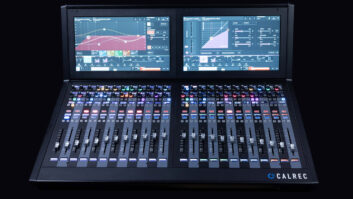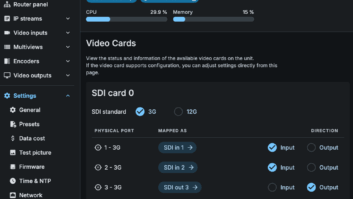
Picture This: Shades of Gray
Mar 1, 2006 12:00 PM,
By Jeff Sauer
The key to lifelike images lies in improved grayscale performance.
A display’s contrast ratio compares the brightness of white to the brightness of black. And as the industry clearly knows: bigger is better, at least all things being equal. But alas, all things aren’t equal, and in January’s “Picture This” I discussed how the quest for big contrast numbers has made this once-critical buyer’s benchmark rather cryptic. Simply put, it doesn’t help much to have a large contrast ratio if it is at the expense of the grayscale range in between.
It’s certainly not that higher contrast is a bad thing. Indeed, if it were truly measurable, our eyes would perceive contrast levels in the millions-to-one. Doesn’t that mean display makers still need to go higher if they are to achieve truly lifelike images? Perhaps, but it’s not that simple.
At any given moment our eyes can comfortably process no more than 100 or 200:1. Yet within that seemingly limited range, we can still see incredible detail, particularly in the variation of grayscale brightness. Our ability to discern much higher contrast comes from our irises, which constantly adapt to different degrees of overall brightness. As our pupils dilate, we effectively spread that instantaneous 200:1 contrast over the much more astounding luminance range.
Display makers argue that in order to accommodate the entire perceptible, global grayscale range, and thus all of the possible bright and dark scenes we’d want to view on a given display, their displays need to have a similarly high contrast ratio. True enough, but high contrast would be possible with 1-bit monochrome processing and it wouldn’t get us any closer to lifelike images. Lifelike images really come from increasing the detail within any given contrast range.
Naturally, no displays use 1-bit monochrome imagery. Most use at least 8-bit processing, and an increasing number of manufacturers are moving toward 10-bit processing, at least on higher-end models. Eight-bit processing increases the two “gray” (black and white) levels of monochrome to 256 levels of gray over the entire range from black to white. Unfortunately, that range is closer to what our eyes can discern at any given level of pupil dilation than what we perceive between pure darkness and full brightness as our pupils dilate over time.
Ten-bit processing represents a potentially significant improvement, and the numbers tell the story. Those two extra data bits create four more permutations, thereby quadrupling the potential number of grays from 256 to 1024 shades. It’s an effective, if brute force, method to improving the image.

Panasonic PT-AE700U
IT’S ALL IN THE IRIS
The Hitachi HDPJ52 LCD projector (reviewed on p. 88) and Panasonic’s PT-AE700U take a different approach that more closely emulates our eyes. An Auto-Iris function improves basic contrast ratio by closing the lamp iris in darker scenes, thereby achieving deeper blacks and, by extension, a higher contrast when compared to white. Lowering blacks to achieve similarly high contrast is done electronically in many other displays. At best, however, that only shifts perceivable grayscales and makes them darker. More commonly, it eliminates grayscale steps by forcing anything close to black to be black.
Alternatively, by adjusting the lamp iris to allow less light to reach the LCD panels, the Auto-Iris gives the LCD panel the chance to use more of its available grayscales steps at those lower brightness levels. For example, imagine that monochrome processing again for a moment and, for the sake of argument, assume that light leakage through the LCD panel really makes the black closer to dark gray. With 1-bit processing there are two steps of gray: white and dark gray. Now add an adjustable lamp iris with two steps. The full-on mode yields those same two grayscale values, but the partially closed mode yields two more: a gray that’s less than white and a truer black. The total is four grays: white, bright gray, dark gray, and black.
Now, imagine that a lamp iris with 10 steps is paired with either the 256 grays of 8-bit or the 1024 grays of 10-bit processing. Each iris step doubles the possible gray values, a potential 20-fold improvement. Of course, neither the Panasonic nor the Hitachi projector reaches that level of grayscale because both limit iris adjustment to darker scenes only. However, the benefit is to retain more grayscale variation in darker scenes where it’s usually most adversely affected by the limits of LCD technology.
New High Dynamic Range imaging goes ever further. Brightside Technologies’ DR37-P is, on the surface at least, similar to other higher-quality 37in. LCD monitors. But it uses 16-bit processing that dedicates a full eight bits to luminance information. The result can yield more than 65,000 shades of gray that can be used to more smartly define shadows and highlights, while still creating brightly lit portions of an image to almost painfully exceed our eyes’ limited 200:1 instantaneous contrast.
Brightside is able to vary the backlight of its LCD panel because rather than a typical defused CCFL backlight, it uses an array of 1,380 LEDs that can be turned on and off and dimmed in nanoseconds, much faster than the 1/60 of a second of a video field. The DR37-P buffers a small group of video frames in order to analyze the luminance levels of the different sections of the picture. Then, by adjusting the LEDs individually or in small groups, it’s able to accommodate not only light and dark scenes, but light and dark portions of each single scene.
The goal of all of these technologies is to retain the subtle detail of dark scenes while preserving the display’s overall brightness capability for well-lit scenes. Naturally, retaining accurate color in both bright and dark scenes is a huge component of lifelike imaging, but retaining grayscale range is the critical first step.
Consider that our eyes and brains are far more sensitive to luminance variations than they are to color change. After all, perceiving subtle variations in the darkness of a nighttime forest could have been the difference between life and death for early man, just as seeing danger in a dark alley could be for us today. Finding a way to improve grayscale performance is far more important to lifelike images than achieving the brightest whites and the darkest blacks.







